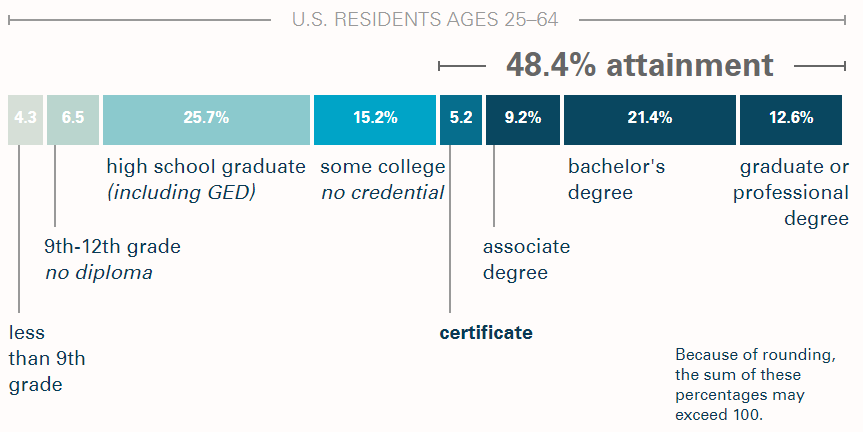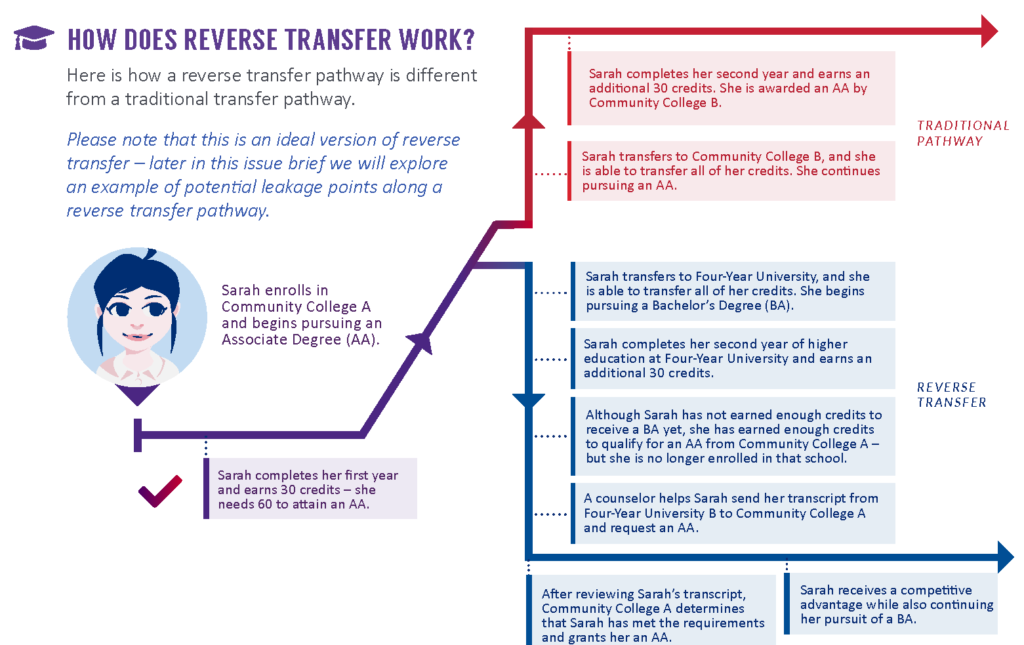Melissa Canney is the Director of Innovation Policy for ExcelinEd.


State leaders want their citizens to prosper and contribute to a thriving state economy. One way they can support this vision is by creating flexible new opportunities that help individuals complete college degrees and credentials.
Currently, fewer than half of Americans ages 25-64 hold a credential beyond high school, according to research from Lumina.

Image Source: Lumina Foundation, A Stronger Nation: Learning beyond high school builds American talent, 2019
But Lumina’s research insists there is cause for optimism because many of those who lack credentials do hold some college credit or have recognizable skills. In fact, the National Student Clearinghouse (NSC) has identified 36 million Americans who are part of the “Some College, No Degree” population: those with some postsecondary education and training but who haven’t completed their program and are no longer enrolled.
The scope of this leaky pipeline is well-illustrated by NSC’s Tracking Transfer report, which highlights student transfer and outcomes data for the 2012 cohort of first-year community college students. Only about 40% of the roughly 200,000 students who transferred from community colleges to universities earned a sub-associates credential or associates degree prior to transferring; the remaining 60% of transfer students advanced to universities with a greater risk of becoming part of the “Some College, No Degree” population. Ultimately, less than half of these community college transfer students earned a bachelor’s degree within six years.
These staggering numbers highlight three distinct, but related, policy challenges that states must address to improve opportunities for their citizens.
Reverse transfer policies are one way states can address these challenges to increase their statewide postsecondary attainment.
Reverse transfer policies between postsecondary institutions allow a community college to award a student an associate degree after the student has transferred to a four-year postsecondary institution whether or not the student completes schooling at the four-year institution. To qualify, a student must have met the requirements for the associate degree through a combination of coursework from the two-year and four-year postsecondary institutions. View ExcelinEd’s Reverse Transfer Model Policy.
The Hunt Institute recently released Reverse Transfers as the latest installment of the Attainment for All: Postsecondary Pathways policy brief series. This comprehensive brief effectively illustrates how policies can either support or hinder individual student’s abilities to complete a postsecondary degree or credential.

Image Source: Hunt Institute, Attainment for All: Postsecondary Pathways – Reverse Transfers, 2020
Reverse transfer policies are increasingly common in states. A 2018 Education Commission of the States 50-state comparison found that, “17 states have reverse transfer policies set in legislation or board policy … (and) 22 states provide reverse transfer opportunities outside of policy, including through institutional agreements, MOUs and statewide programs.”
More students than ever before have increased flexibility to complete degrees across community college and university systems – but there are still many students who live in states or attend institutions that do not have reverse transfer policies. Policymakers in states that do not have reverse transfer policies should consider this approach.
However, passing this relatively straightforward policy is just the first step to ensure individuals can—and do—access these new opportunities. There’s something frequently missing from the available information and research on postsecondary attainment, as well as from most of the policy discussions: the full alignment of policies and systems that span all types of postsecondary institutions to support student degree and credential completion.
Technical colleges and other postsecondary institutions that award sub-associate/sub-baccalaureate degrees and industry-recognized short-term and long-term certificate credentials are often conspicuously left out of (or at best tenuously connected to) state-level prior learning policies like reverse transfer. This reality presents a huge opportunity for states, as these institutions often offer a high return on investment for students in terms of time-to-credential completion and immediate employment and earnings.
Policymakers, state agencies and postsecondary institutions have the opportunity to support a full statewide reverse transfer policy—and other types of prior learning—across all types of postsecondary institutions. Taking a more expansive approach will require states to identify and address challenges that have developed over decades, such as:
We encourage states to consider using reverse transfer policies to address these challenges across all types of postsecondary institutions. All states, whether adopting a new reverse transfer policy or expanding a current one, will need to strategize the best way to ensure their reverse transfer policies improve opportunities for their students and state. They can do this by:
These are not easy conversations, and they require consistent stakeholder buy-in and engagement. But they are conversations worth having—and conversations I challenge you to start with partners and policymakers in your state.
